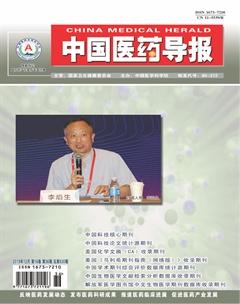抑制JNK通路對染料木黃酮誘導肝癌MHCC97-L細胞凋亡及caspase-3和caspase-9活性的影響
劉晟男 錢甜甜 郎慧玲


[摘要] 目的 探討抑制JNK通路對染料木黃酮(Genistein)誘導肝癌MHCC97-L細胞凋亡及caspase-3和caspase-9活性的影響。 方法 實驗分為對照組、SP600125(SP)10、20、30 μmol/L組。蛋白質印跡法篩選SP的最適工作濃度。實驗分對照組、Gen組、SP組和聯用組,倒置顯微鏡、熒光顯微鏡和分光光度法分別檢測細胞凋亡形態、細胞凋亡指數、caspase-3和caspase-9活化水平。 結果 SP能明顯阻斷P-JNK蛋白表達(P < 0.01),其最小工作濃度為20 μmol/L。倒置顯微鏡下,各藥物組細胞均出現染色質著色變深或局部凝集的凋亡特征性改變,以聯用組細胞變化最為明顯。熒光顯微鏡下,各藥物組均可觀察到早期凋亡和晚期凋亡細胞。與對照組比較,所有藥物組凋亡指數均明顯升高(P < 0.01),且聯用組高于Gen組和SP組(P < 0.01)。與對照組比較,所有藥物組的caspase-3和caspase-9活性均明顯升高(P < 0.01)。與Gen組、SP組比較,聯用組caspase-3活性最高(P < 0.01),SP組caspase-3活性高于Gen組(P < 0.01);聯用組caspase-9活性高于Gen組(P < 0.01),SP組與Gen組、聯用組與SP組caspase-9活性差異均無統計學意義(P > 0.05)。 結論 抑制JNK通路可通過激活caspase依賴的線粒體途徑來促進Genistein誘導MHCC97-L細胞凋亡。
[關鍵詞] 染料木黃酮;JNK通路;肝癌MHCC97-L細胞;細胞凋亡
[中圖分類號] R735.7 ? ? ? ? ?[文獻標識碼] A ? ? ? ? ?[文章編號] 1673-7210(2019)12(c)-0019-05
Effect of Genistein inducing liver cancer MHCC97-L cells apoptosis and activity of caspase-3 and caspase-9 through inhibiting JNK pathway
LIU Shengnan1 ? QIAN Tiantian1 ? LANG Huiling1 ? YU Jiaqi1 ? XIONG Mengqi1 ? ZHAO Zhongxin2 ? MEI Qingbu1 ? LIU Dan1
1.Basic Medical College, Qiqihar Medical University, Heilongjiang Province, Qiqihar ? 161006, China; 2.Department of General Surgery, the First Affiliated Hospital of Qiqihar Medical University, Heilongjiang Province, Qiqihar ? 161041, China
[Abstract] Objective To explore the effect of Genistein inducing liver cancer MHCC97-L cells apoptosis and activity of caspase-3 and caspase-9 through inhibiting JNK pathway. Methods The experiment was divided into control group and SP600125 (SP) 10, 20, 30 μmol/L groups. Western blotting was carried out to search the optimum working concentration of SP. The experiment was divided into control, Gen, SP and combined groups. Apoptosis morphology, apoptosis index, activity of caspase-3 and caspase-9 were detected by inverted microscope, fluorescence microscope and spectrophotometry respectively. Results SP obviously blocked the expression of P-JNK protein at a minimum working concentration of 20 μmol/L (P < 0.01). Under inverted microscope, chromatin became darker or condensate in each drug group, and cell changes most obvious in combined group. Early apoptotic cells and late apoptotic cells were observed under fluorescence microscope. Compared with control group, apoptotic index of all drug groups was significantly increased (P < 0.01), among which apoptotic index of combined group was highest and pro-apoptotic effect was stronger than that of Gen group and SP group (P < 0.01). Compared with control group, the activity of caspase-3 and caspase-9 in all drug groups were significantly increased (P < 0.01). Compared with Gen group and SP group, the activity of caspase-3 in combination group was the highest (P < 0.01), and the activity of caspase-3 in SP group was higher than that in Gen group (P < 0.01). The activity of caspase-9 in the combination group was higher than that in the Gen group (P < 0.01), while the activity of caspase-9 in the SP group and Gen group and the combined group and the SP group have no significant differences (P > 0.05). Conclusions These results suggest that inhibition of JNK pathway can promote the apoptosis of Gen induced MHCC97-L cells by activating the caspase-dependent mitochondrial pathway.
[Key words] Genistein; JNK pathway; Liver cancer MHCC97-L cells; Apoptosis
目前肝癌是全球癌癥死亡的第四大原因[1],是中國癌癥死亡的第二大原因[2],盡管在預防、篩查、診斷和治療肝癌方面的技術都取得了新進展,但肝癌的發病率和死亡率仍持續上升。值得關注的是女性患肝癌的風險低于男性[3-4],這種差異與雌激素水平有關[5-6]。染料木黃酮(Genistein,簡稱Gen)是一種具有雌激素活性的天然物質,最新的研究表明[7],膳食攝取Gen可通過caspase途徑增加肝癌細胞凋亡,抑制肝癌的發生和發展。逃避凋亡是癌癥的特征之一[8],c-Jun氨基末端激酶(JNK)是調控細胞凋亡的重要信號通路,在肝癌細胞系、肝癌組織樣本和肝癌異種移植瘤中,JNK1的活性升高[9],且與患者預后較差有關[10]。SP600125(SP)是一種強效的JNK通路抑制劑,可以抑制JNK磷酸化。盡管Gen是一種已知的肝癌抑制因子,但其作用機制尚未闡明。基于JNK與凋亡的密切聯系,本研究以人肝癌MHCC97-L細胞為研究對象,在課題組的前期研究基礎之上[11-13],探討抑制JNK通路對caspase依賴的線粒體凋亡的影響。
1 材料與方法
1.1 主要材料
人肝癌MHCC97-L細胞購自復旦大學肝癌研究所。Gen(批號:G6649-25mg)購自Sigma公司;SP(批號:A2714)購自Santa Cruz公司;DMEM高糖培養液(批號:AC11223264)購自Hyclone公司;胎牛血清(批號:20170713)購自杭州四季青公司;caspase-3(批號:2018-02-10)、caspase-9(批號:2018-03-03)蛋白活化檢測試劑盒和Annexin V-FITC/PI細胞凋亡試劑盒(批號:20170327)購自南京凱基生物公司;T-JNK多克隆抗體(批號:B3901)和P-JNK (T183/Y185)多克隆抗體(批號:B6701)購自Immunoway公司;β-actin多克隆抗體(批號:12cm81)購自武漢博士德生物公司。
1.2 實驗方法
1.2.1 細胞培養 ?MHCC97-L細胞用含10% FBS的DMEM高糖培養液置于37℃、5% CO2培養箱中培養。實驗分兩個系列組,第一系列分為對照組、SP 10、20、30 μmol/L組;第二系列分為對照組、Gen組(80 μmol/L)、SP組(20 μmol/L)和聯用組(SP 20 μmol/L+Gen 80 μmol/L)。取狀態良好的對數生長期細胞用于后續實驗。
1.2.2 蛋白質印記法篩選SP的最適工作濃度 ?細胞以5×105個/孔接種于6孔板,加入第一系列處理因素的培養液2 mL,處理6 h后,收集細胞,提取細胞蛋白,BCA法進行蛋白定量,調整樣品蛋白濃度為2 μg/μL,樣品蛋白煮沸變性。取各組樣品蛋白30 μg上樣,經SDS-PAGE電泳分離后,轉移至NC膜上,封閉2 h,TBS洗滌3次,一抗P-JNK(1∶1000)、T-JNK(1∶1000)、β-actin(1∶400)4℃孵育過夜,TBST洗滌3次,HRP標記二抗室溫2 h,TBS洗滌2次,TBST洗滌1次,ECL發光,顯影,定影,目的蛋白表達量用相對灰度值表示。
1.2.3 倒置顯微鏡觀察細胞的形態學變化 ?細胞以1×105個/孔接種于12孔板,加入第二系列處理因素的培養液1.5 mL,處理48 h后,倒置顯微鏡下觀察細胞的數量及形態學變化。
1.2.4 熒光顯微鏡檢測細胞凋亡指數 ?細胞以5×104個/孔接種于24孔板,加入第二系列處理因素的培養液1 mL,處理48 h后,PBS洗滌細胞2次,加入Annexin V-FITC和PI的混合液,室溫避光反應5 min,于熒光顯微鏡下,用雙色濾光片觀察,Annexin V-FITC呈綠色信號,PI呈紅色信號。在高倍鏡(400×)下隨機計數5個視野,計算各組細胞凋亡指數,用凋亡細胞數與細胞總數的比值來表示。
1.2.5 分光光度法檢測caspase-3、caspase-9活化程度 ?細胞以3×106濃度接種于60 mm培養皿中,加入第二系列處理因素的培養液5 mL,培養48 h后,收集細胞,抽提細胞蛋白,BCA法進行蛋白定量,調整樣品蛋白濃度為2 μg/μL。取50 μL的樣品蛋白,加入caspase-3或caspase-9 Substrate,37℃避光孵育4 h,于酶標儀檢測405 nm的吸光度值。用藥物組與對照組的吸光度比值來表示各藥物組caspase-3和caspase-9的活化程度。
1.3 統計學方法
采用SPSS 22.0軟件進行統計分析,計量資料以均數±標準差(x±s)表示,組間比較采用單因素方差分析,兩兩比較采用LSD檢驗。以P < 0.05為差異有統計學意義。
2 結果
2.1 蛋白質印跡法檢測P-JNK蛋白的表達
與對照組比較,SP 3個組中P-JNK蛋白表達均顯著降低(P < 0.01)。SP最小工作濃度為20 μmol/L。見圖1。
2.2 倒置顯微鏡檢測細胞凋亡的形態學變化
所有藥物組細胞密度降低,細胞皺縮、變形、透明度下降,細胞質可見較大的“空泡”結構,核仁不清晰,染色質著色變深或局部凝集,聯用組細胞變化最為明顯。見圖2。
2.3 熒光顯微鏡檢測細胞凋亡指數
熒光顯微鏡下,各藥物組均可觀察到早期凋亡和晚期凋亡細胞。與對照組比較,所有藥物組的凋亡指數均明顯升高(P < 0.01),聯用組凋亡指數高于Gen組、SP組(P < 0.01),但Gen組和SP組比較,差異無統計學意義(P > 0.05)。見圖3。
2.4 分光光度法檢測MHCC97-L細胞caspase-3及caspase-9的活性
與對照組比較,所有藥物組的caspase-3和caspase-9活性均明顯升高(P < 0.01);與Gen組、SP組比較,聯用組caspase-3活性最高(P < 0.01),SP組caspase-3活性高于Gen組(P < 0.01);聯用組caspase-9活性高于Gen組(P < 0.01),SP組與Gen組、聯用組與SP組caspase-9活性差異均無統計學意義(P > 0.05)。見圖4。
3 討論
JNK屬于絲裂原活化蛋白激酶家族(MAPKs),由3個基因編碼,JNK1和JNK2廣泛表達于大多數細胞和組織,JNK3主要在心臟、大腦和睪丸中表達。JNK作為一類蛋白激酶,可被多種應激因素所激活,激活后可以磷酸化核內和胞質內的許多靶向底物,意味著JNK既可以通過核轉錄途徑,也可以直接作用于胞質底物,如Bcl-2家族蛋白,來調節細胞的生物學效應,而且JNK在細胞增殖和細胞凋亡之間起關鍵的調控作用,這兩種生物學效應之間的平衡,通常是由細胞環境所決定的,最終決定細胞增殖或者凋亡[14-16]。JNK介導的線粒體凋亡是由caspase-9啟動的內源性凋亡途徑,調控抗凋亡蛋白Bcl-2活性和促凋亡蛋白Bax和Bad轉位,增加線粒體膜的通透性,導致線粒體釋放細胞色素C,觸發caspase-9級聯反應,最終激活caspase-3[17]。
JNK在癌癥發展中的作用在已報道的研究中,結果不一,顯示其具有雙面效應,肝癌亦是如此。一些研究支持激活JNK具有促進肝癌的作用。與癌旁肝組織比較,大約56%的肝癌組織JNK1被激活[9,18],比較High-JNK1和Low-JNK1肝癌組織的基因表達譜確定了927個過表達的與JNK1相關的標記基因[10]。用JNK抑制劑D-JNK1處理肝癌異種移植瘤小鼠,可觀察到腫瘤組織減小了一半,明確了JNK1的活性在小鼠肝癌形成后期是必需的[8]。骨髓細胞特異性JNK缺乏的小鼠表現出對肝細胞炎癥和肝癌的抑制作用[19],提示非肝實質細胞也可能作為JNK功能的位點,因此用抑制JNK的藥物靶向骨髓細胞可能作為炎癥性肝病的治療方案。當肝癌細胞同時暴露于順鉑和SP時,細胞生長受到更大的抑制,細胞凋亡得到促進,提示抑制JNK通路可以增強肝癌細胞對順鉑的敏感性[20]。本研究結果顯示,Gen能通過活化caspase-9和caspase-3激活線粒體凋亡通路,且抑制JNK通路可顯著提升Gen的促MHCC97-L細胞凋亡作用。值得注意的是SP在上調caspase-3活性的作用中明顯高于Gen(P < 0.01),雖然SP在caspase-9活性和細胞凋亡率中與Gen差異無統計學意義(P > 0.05),但是顯示出略強的作用趨勢。SP與聯合組caspase-9活性差異無統計學意義(P > 0.05),進一步提示Gen可能主要通過JNK通路來調控caspase-9的活化水平。因此,JNK通路可能成為一個更為強效的抗腫瘤靶點。另一部分研究提供了JNK活化有抑制肝癌的證據。姜黃素衍生物WZ35可以顯著抑制肝癌細胞的增殖、侵襲和遷移,并能促進Ros依賴的JNK活化,但是SP可以顯著逆轉WZ35引起的上述作用[21]。高車前素是一種酚類黃酮,對肝癌細胞具有抗增殖作用,激活caspase-3,誘導肝癌細胞凋亡,同樣應用SP能顯著抑制高車前素在肝癌細胞的抗癌作用[22]。以上實驗資料支持了JNK通路在肝癌細胞增殖、凋亡、侵襲和化療反應等方面的雙重作用,這可能與細胞類型、所受的刺激因素、通路靶向信號分子的多樣性、信號分子持續活化的水平和作用時間有關,因此JNK通路如何在細胞生存和細胞死亡之間做出選擇,尚待深入研究。
[參考文獻]
[1] ?Bray F,Ferlay J,Soerjomataram I,et al. Global cancer statistics 2018:GLOBOCAN estimates of incidence and mortality worldwide for 36 cancers in 185 countries [J]. CA Cancer J Clin,2018,68(6):394-424.
[2] ?孫可欣,鄭榮壽,張思維,等.2015年中國分地區惡性腫瘤發病和死亡分析[J].中國腫瘤,2019,28(1): 1-11.
[3] ?Yip TC,Chan HL,Wong VW,et al. Impact of age and gender on risk of hepatocellular carcinoma after hepatitis B surface antigen seroclearance [J]. J Hepatol,2017,67(5):902-908.
[4] ?趙金哲,王娟,沐勇杰,等.肝癌微波消融中熱損傷參數分析[J].北京生物醫學工程,2019,38(4):392-399,423.
[5] ?Wang YC,Xu GL,Jia WD,et al. Estrogen suppresses metastasis in rat hepatocellular carcinoma through decreasing interleukin-6 and hepatocyte growth factor expression [J]. Inflammation,2012,35(1):143-149.
[6] ?Naugler WE,Sakurai T,Kim S,et al. Gender disparity in liver cancer due to sex differences in MyD88-dependent IL-6 production [J]. Science,2007,317(5834):121-124.
[7] ?Lee SR,Kwon SW,Lee YH,et al. Dietary intake of genistein suppresses hepatocellular carcinoma through AMPK-mediated apoptosis and anti-inflammation [J]. BMC Cancer,2019,19(1):6.
[8] ?Hanahan D,Weinberg RA. Hallmarks of cancer:the next generation [J]. Cell,2011,144(5):646-674.
[9] ?Hui L,Zatloukal K,Scheuch H,et al. Proliferation of human HCC cells and chemically induced mouse liver cancers requires JNK1-dependent p21 downregulation [J]. J Clin Invest,2008,118(12):3943-3953.
[10] ?Chang Q,Chen J,Beezhold KJ,et al. JNK1 activation predicts the prognostic outcome of the human hepatocellular carcinoma [J]. Mol Cancer,2009,8:64.
[11] ?王鈺粟,梅慶步,鄭立紅,等.Genistein與5-FU誘導肝癌細胞凋亡協同作用機制研究[J].中華腫瘤防治雜志,2015,22(10):758-763.
[12] ?趙忠新,遲大鵬,王鈺粟,等.Genistein與5-FU通過p42/44 MAPK通路調控Bax誘導肝癌細胞凋亡[J].世界華人消化雜志,2014,22(14):2003-2007.
[13] ?郭鵬,朱為康,李雁,等.欖香烯乳劑治療中晚期肝癌的療效與安全性的臨床觀察[J].世界中醫藥,2018,13(3):676-678,682.
[14] ?Zeke A,Misheva M,Reményi A,et al. JNK Signaling: Regulation and Functions Based on Complex Protein-Protein Partnerships [J]. Microbiol Mol Biol Rev,2016, 80(3):793-835.
[15] ?Mollereau B,Ma D. Rb-mediated apoptosis or proliferation:It′s up to JNK [J]. Cell Cycle,2016,15(1):11-12.
[16] ?Gkouveris I,Nikitakis NG. Role of JNK signaling in oral cancer:A mini review [J]. Tumour Biol,2017,39(6):1010 428317711659.
[17] ?Dhanasekaran DN,Reddy EP. JNK-signaling:A multiplexing hub in programmed cell death [J]. Genes Cancer,2017,8(9-10):682-694.
[18] ?Chang Q,Zhang Y,Beezhold KJ,et al. Sustained JNK1 activation is associated with altered histone H3 methylations in human liver cancer [J]. J Hepatol,2009,50(2):323-333.
[19] ?Han MS,Barrett T,Brehm MA,et al. Inflammation Mediated by JNK in Myeloid Cells Promotes the Development of Hepatitis and Hepatocellular Carcinoma [J]. Cell Rep,2016,15(1):19-26.
[20] ?Liu XY,Liu SP,Jiang J,et al. Inhibition of the JNK signaling pathway increases sensitivity of hepatocellular carcinoma cells to cisplatin by down-regulating expression of P-glycoprotein [J]. Eur Rev Med Pharmacol Sci,2016,20(6):1098-1108.
[21] ?Wang L,Han L,Tao Z,et al. The curcumin derivative WZ35 activates ROS-dependent JNK to suppress hepatocellular carcinoma metastasis [J]. Food Funct,2018,9(5):2970-2978.
[22] ?Han M,Gao H,Ju P,et al. Hispidulin inhibits hepatocellular carcinoma growth and metastasis through AMPK and ERK signaling mediated activation of PPARγ [J]. Biomed Pharmacother,2018,103:272-283.
(收稿日期:2019-09-10 ?本文編輯:劉永巧)

